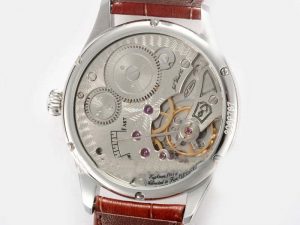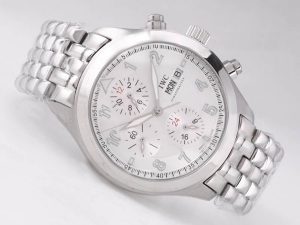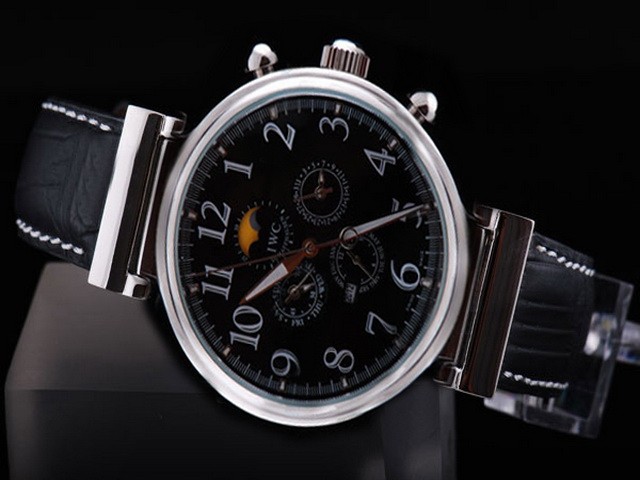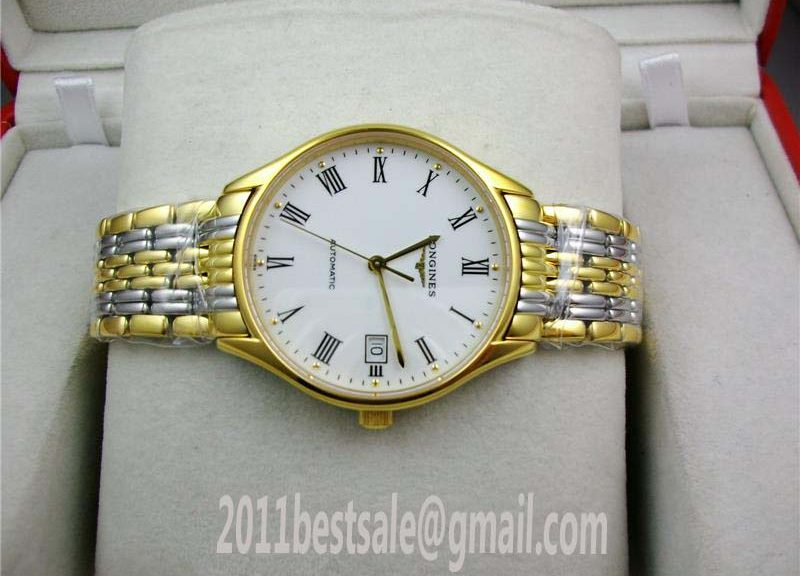IWC has a large number of very famous watch models to their name, such as, the Big Pilot, the Ingenieur, the Da Vinci and others. Today, we take a general view of their dressier models, the Portofino and the Portugieser Chronograph. Join us as we examine the similarities and differences between these two classic replica IWC watches. Here are the Portofino Hand-Wound Eight Days and the Portugieser Chronograph. 
The design of both these watches from the IWC collection, the Portofino and the Portugieser Chronograph, are greatly inspired by pocket watches. In fact, the very first time-only Portugieser (formerly known as the Portuguese) from 1939 was a hunter-style wristwatch powered by a pocket watch movement. While the Portugieser Chronograph version only the joined the lineup in 1998, it kept most of the signature design details of the inaugural model from 1939. The Portofino, on the other hand, made its debut in 1984, drawing inspiration from Lepine pocket watches.
As far as the size is concerned, the case of the Portofino Hand-Wound Eight Days measures a generous 45mm while the Portugieser Chronograph is smaller at 40.9mm. Yet, due to their movements, the 11.7mm thick Portofino is slighter slimmer than the 12.6mm thick Portugieser Chronograph. The Portofino is crafted in stainless steel while the Portugieser Chronograph is in 18k rose gold in our specific examples. However, both collections offer models in steel and gold.
When looking at the face of the replica watches, you’ll find that they’re both expansive thanks to slim bezels. The Portugieser Chronograph ref. IWC fake watch has its characteristic duo of registers at the top and bottom of the dials—the minute counter followed by the running seconds, respectively. What’s more, the slate dial houses Arabic numerals all around in addition to the tachymeter scale on the periphery. 
Conversely, the Portofino Hand-Wound Eight Days model has its characteristic stick indexes encircling its silver dial joined by a sole Roman numeral at 12 o’clock. There’s also a subtle outer minute track. The well-balanced dial includes a date window at 3 o’clock, a running seconds subdial at 6 o’clock and a power reserve indicator at 9 o’clock.
Both the Portofino and the Portugieser Chronograph are amazingly popular models within the replica IWC catalog. And given their beautiful designs, that isn’t a surprise at all. The Portofino is larger but slimmer while the Portugieser Chronograph is thicker and includes the duo of pushers for more heft. One is manual while the other is automatic. In our examples, one sports a steel case with a light dial while the other has a rose gold case with a dark dial.
As with any other luxury watch, it really comes down to personal preference since either the IWC Portugieser Chronograph or IWC Portofino would be an awesome addition to any watch collection.
Monthly Archives: December 2017
Introduction of the groundbreaking replica Zenith Defy Lab
The first fruits of a more synergized approach to watch-making at LVMH comes to light this week, with the unveiling of replica Zenith’s Defy Lab, a collaboration between the best-decorated Le Locle manufacture, the R&D department of replica Hublot and Guy Semon, CEO of the luxury group’s R&D Institute, Watch Division, based at the fake TAG Heuer.
And the results are even more remarkable than Zenith’s landmark achievement to some extent, the legendary El Primero from 1969, the first serially produced chronograph capable of measuring to 1/10th of a second, made possible by the higher than normal oscillating frequency. Because today Zenith has announced a new movement beating at an incredible 15hz or ten times more accurately than the original El Primero.
Featured inside a revamped movement called the ZO 342 is a completely new regulating system dubbed the Zenith Oscillator, which replaces the coupled balance and hairspring system devised by the astronomer and physicist Christian Huygens back in 1675 with a single element measuring just 0.5mm in thickness.
The Oscillator itself is made from monocrystalline silicon and its two components replace the 30 or so parts that comprise the traditional sprung balance system. The use of monocrystalline silicon obviates the need for lubrication, resulting in less friction, which – in tandem with the increased frequency – achieves far greater accuracy for 95 per cent of its 60-hour power reserve.
This gives the Defy Lab a triple-whammy of credentials: chronometer certification awarded on behalf of the International Bureau of Weights and Measures (BIPM), as well as thermal and anti-magnetic properties that meet criteria laid down by the International Organisation for Standards (ISO). As the replica Zenith describes it, “This mechanism opens up a new dimension, representing no less than a reinvention of the Huygens principle with another mechanical cheap replica watch.”
Initially offered in ten unique pieces, the Zenith Defy Lab features a 44mm case made from a patent-pending aluminium composite developed by the R&D team at Hublot, called Aeronith, which is billed as 1.7 times lighter than aluminium and 10% lighter than carbon fibre. The ZO 342 caliber measures just 8.13mm thick with the Zenith Oscillator itself visible through the open-worked dial.
Ultimately, it aims to industrialize the Zenith Oscillator in much the same way as the El Primero, but until then there’s the Defy El Primero 21, a chronograph capable of measuring to 100th of a second via a central seconds hand, the first series-made chronograph able to do so, and the debut piece in this newly-minted line of Defy watches.

